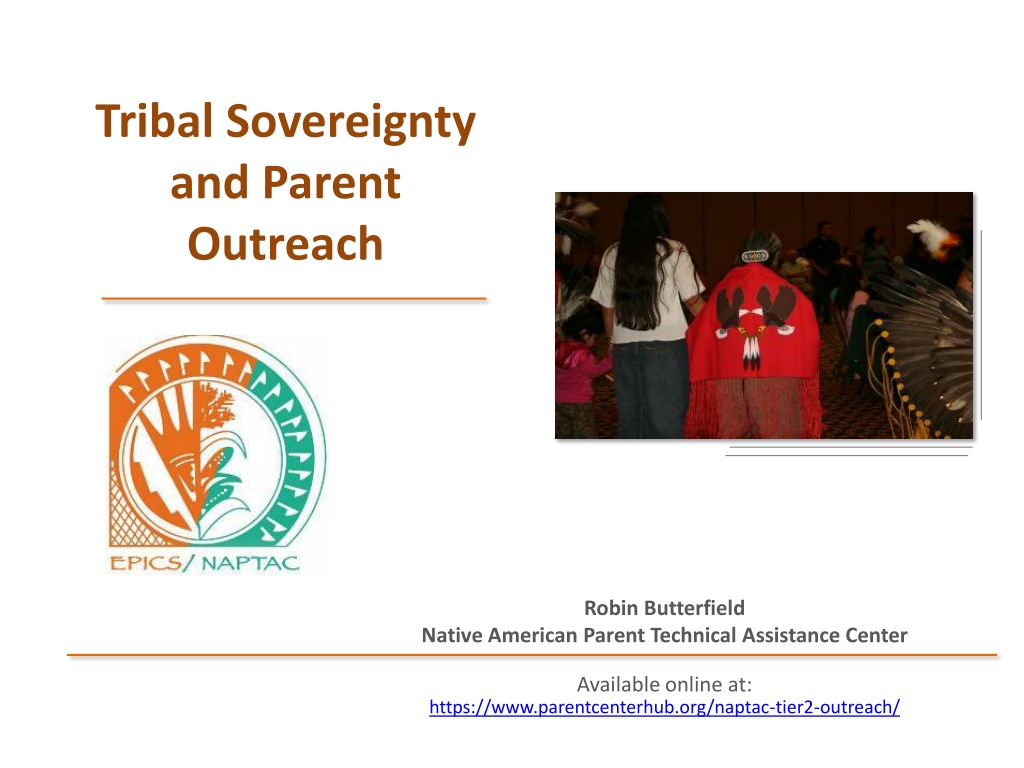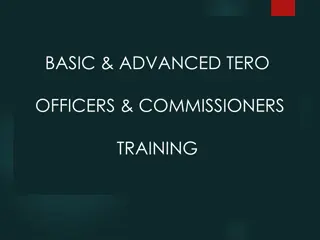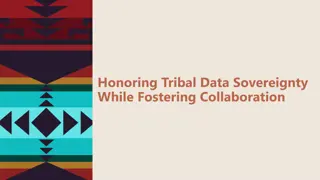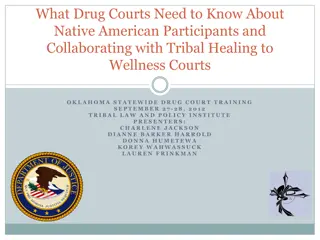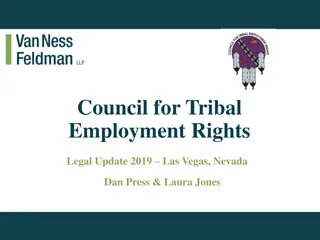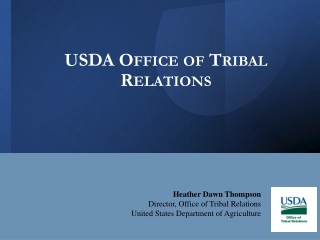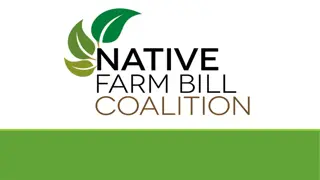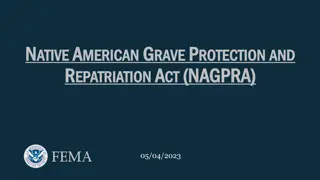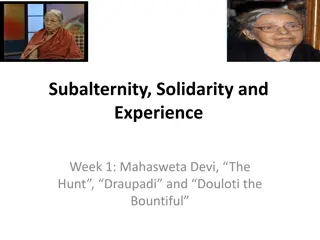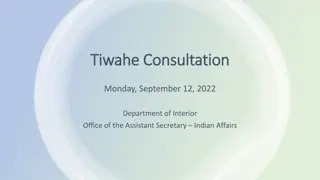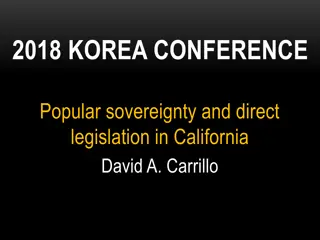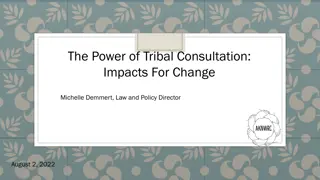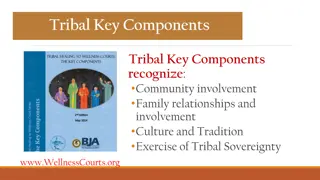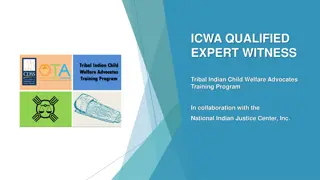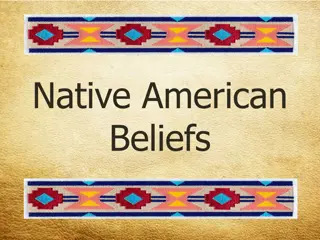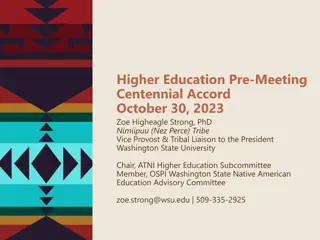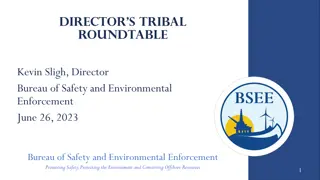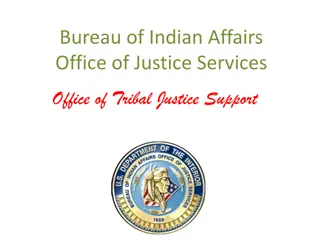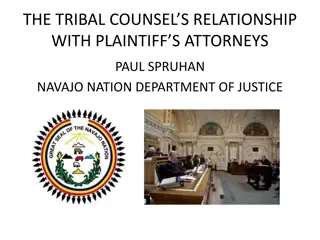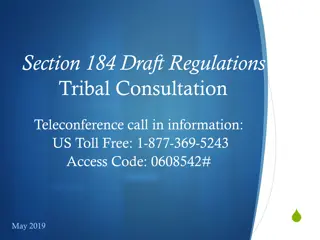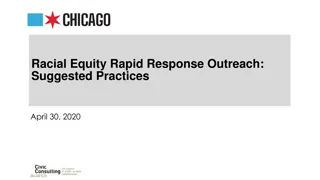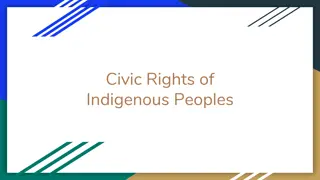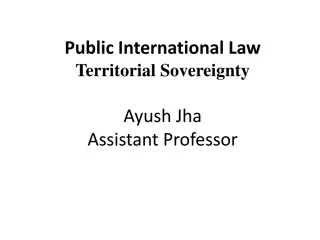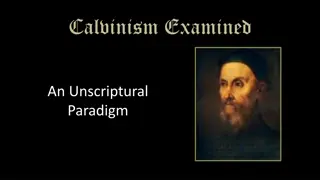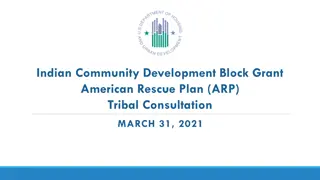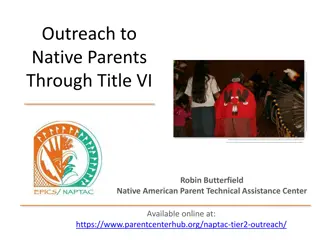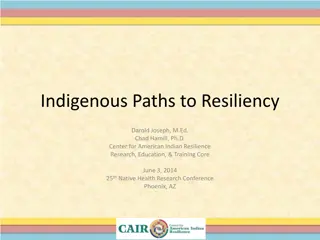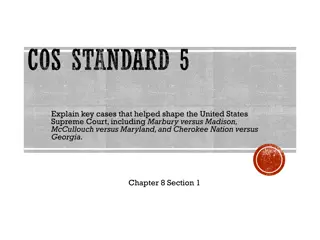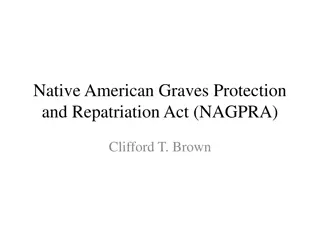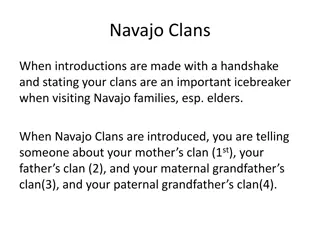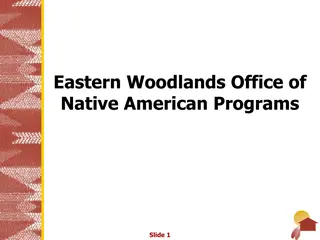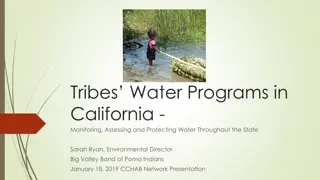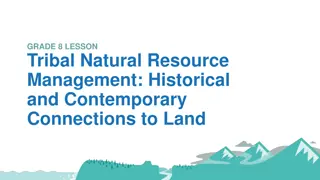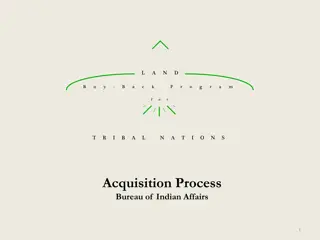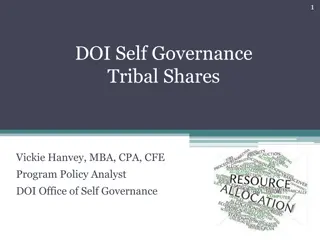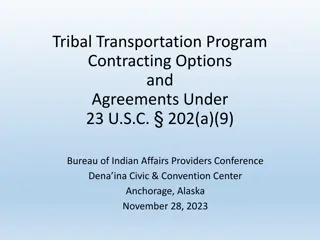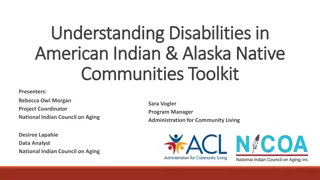Understanding Tribal Sovereignty and Parent Outreach in Native American Communities
Explore the significance of tribal sovereignty, benefits of treaties, and effective outreach strategies in Native American communities. Delve into the implications of sovereignty, treaty-making, and parental engagement within these contexts.
- Tribal sovereignty
- Parent outreach
- Native American communities
- Treaty benefits
- Sovereignty understanding
Download Presentation

Please find below an Image/Link to download the presentation.
The content on the website is provided AS IS for your information and personal use only. It may not be sold, licensed, or shared on other websites without obtaining consent from the author. Download presentation by click this link. If you encounter any issues during the download, it is possible that the publisher has removed the file from their server.
E N D
Presentation Transcript
Tribal Sovereignty and Parent Outreach Robin Butterfield Native American Parent Technical Assistance Center Available online at: https://www.parentcenterhub.org/naptac-tier2-outreach/
Education There is no such thing as a neutral educational process. Education either functions as an instrument which is used to facilitate the integration of the younger generation into the logic of the present system and bring about conformity to it, or it becomes the practice of freedom, the means by which men and women deal critically and creatively with reality and discover how to participate in the transformation of their world. Paolo Friere
Success Targets 1. I can explain what tribal sovereignty is. 2. I can list some of the benefits of treaties for tribes. 3. I can list some of the benefits of treaties for the U.S. Federal Government. 4. I have some strategies for doing outreach with American Indian/Alaska Native (AI/AN) tribes and communities.
Agenda for Todays Webinar What is sovereignty? Why is sovereignty important to understand when working with tribes and tribal members? How did treaty making affirm tribal sovereignty? How did treaty making benefit tribes and the U.S. government? What are some considerations for outreach to Native parents?
What do we already know about tribal sovereignty? Think-pair-share How would you define sovereignty? Why are tribes said to be sovereigns?
Common Misconception Tribal sovereignty means that. It's sovereign. You're a ... you're a ... you've been given sovereignty and you're viewed as a sovereign entity.
U.S. Constitution, Article I Section 8: The congress shall have the Power to lay and collect taxes, Duties, Imposts and Excises, to pay the debts and to provide for the common Defense and general Welfare of the United States; but all Duties, Imposts and Excises, shall be uniform throughout the United States; To borrow Money on the credit of the United States; To regulate Commerce with foreign Nations and among the several states, and with the Indian Tribes
Why is Sovereignty Important to Understand? Sovereignty: Constitutes a legal, political status, and acknowledges the right of self- government. Means that rules, customs, cultures, and protocols among tribes and communities will vary. Recognizes tribal governments as distinct, independent entities with unique authority. Sets AI/ANs apart from all other ethnic and racial groups.
U.S. Constitution, Article VI This Constitution, and the laws of the United States which shall be made in pursuance thereof; and all treaties made, or which shall be made, under the authority of the United States, shall be the supreme law of the land; and the judges in every state shall be bound thereby, anything in the Constitution or laws of any State to the contrary notwithstanding.
Learning & & Teaching about Tribal Sovereignty An understanding of Tribal sovereignty is key to understanding many current issues involving American Indians/Alaska Natives. Tribal sovereignty is best understood in the context of lessons on politics and government. Concepts related to Tribal sovereignty can be introduced as early as 3rd-4th grade. For example
Inherent Rights Tribes were already governing their lands and themselves before contact. Pre-existing, inherent rights were retained via treaties. Inherent rights have been re-affirmed repeatedly through case law and the Supreme Court.
Powers Inherent to Sovereigns To determine their form of government To impose and collect taxes To make and enforce laws To appropriate monies To define conditions for citizenship in the nation To regulate property use To regulate domestic and international trade
Powers Inherent to Sovereigns (continued) To regulate domestic relations of its members (marriage, divorce, etc.) To establish a monetary system To make war and peace To form alliances with other nations through treaties, contracts, or agreements
Responsibilities of Sovereignty The exercise and recognition of Tribal sovereignty affects every issue that tribal communities are facing, including but not limited to: Education Environmental protection Healthcare Safety and security (including civil and criminal jurisdiction) Taxation Economic development
Treaties and Treaty Making Why were treaties made?
Treaties and Treaty Making (continued) Treaties are formal, negotiated agreements between governments. Each party takes on certain responsibilities and obligations, which limit the exercise of sovereignty for both parties. Under Article VI of the U.S. Constitution, treaties are part of the Supreme Law of the Land.
Treaties and Treaty Making (continued) Treaties are land contracts or grants of rights to the United States by Tribes. Through treaties, Tribal rights are: Expressly retained Expressly relinquished Expressly not relinquished
Treaties and Treaty Making 1600-1776 | Colonial treaties 1778-1810 | Early treaties of alliance or peace Federal Government Periods of Treaty Making 1784-1817 | Beginning land cessions 1861-1865 | Civil War treaties 1865-1868 |Great Peace Commissions 1871 | End of treaty making; beginning of agreements
Activity: Right or Privilege? Group participants in the middle of the room. On the right side of room post the word Right. Privilege On the left side of the room post the word Privilege. Right As statements are read, participants will walk either right or left. Once in place, participants will discuss why they are standing where they are. Participants will then return to the center of the room to await the next statement.
Activity: Right or Privilege There is a distinction between personal rights, rights of groups, and rights of nations. Rights issues are complex and are often taken to court. Courts have tended to rule in favor of Tribal rights. The binding, legal agreements between Tribes and the Federal Government establish why there is a distinction between Indians and other racial/ethnic groups.
Benefits to the U.S. Government Treaties with Tribes gave the U.S. Government: Millions and millions of acres of land, water, timber, and minerals Sources of economic development Land held in the public domain for forests and parks Resources to pay off the national debt and finance the new government s operations
Benefits to Tribes Treaties retained for Tribes: Tracts of land (some held in trust by the Federal Government) The right to continue to hunt, gather, and fish in usual accustomed places The right to continue to govern their own affairs Protections and services, like healthcare and education
Dual Citizenship American Indians/Alaska Natives are citizens of their individual sovereign nations andthe United States. The Indian Citizenship Act of 1924
A Test of Sovereignty: Washington State vs. Tribes The fishing wars and the importance of fighting for sovereign rights The importance of the Boldt Decision as a landmark Supreme Court decision Ongoing public ignorance about sovereignty
Early Treaties in Washington State But The right of taking fish at all usual and accustomed grounds and stations is secured to said Indians in common with all citizens of the Territory, and of erecting temporary houses for the purpose of curing the same In the 1850s, the United States entered into a series of treaties with the American Indian tribes of the Pacific Northwest. While the tribes agreed to part with their land, they insisted on protecting their fishing rights throughout the Washington territory. Treaty of Olympia, 1858
Misconception of Treaties in Washington State United States v. Washington Known as the Boldt Decision, 1975 Initially, the federal government honored its treaties with the Tribes, but The court held that: The 8 treaties between the Tribes of the Puget Sound and the U.S. remained fully in force; The Tribes were and continue to be sovereign governments with authority to regulate salmon harvesting; and Tribes had the right to harvest 50% of all salmon in the Pacific Northwest. In 1889 Washington became a state and passed laws to curtail tribal fishing in the name of conservation.
Misconception of Treaties in Washington State The truest and most profound fact about the Boldt Decision is that it was conceived and accomplished by Indian people themselves The Indian people at the council tables, on the rivers, on the shores, at the smoke houses and at the sacred sites who had the vision, strategy, and fierce determination to carry out a victorious crusade that at the beginning seemed impossible to all but themselves. Charles Wilkinson (2014) | University of Colorado School of Law
Misconception of Treaties But the beat still goes on ? Initiative 456 Approved November 6, 1984 .No citizen shall be denied equal access to and use of any resource on the basis of race, sex, origin, cultural heritage, or by and through any treaty based upon the same. Federal law supersedes state law and thus this state law and others like it are illegal.
A Precedent Set Among the major changes that followed the decision: The Boldt Decision set a precedent for government-to- government cooperation in other areas, a balance of power that previously had not been taken seriously by the state. 1988 | Puyallup Land Claims Settlement 1988 | National Indian Gaming Regulatory Act 1989 | Centennial Accord 1994 | Shellfish Decision (US District Judge Edward Rafeedie) 2007 | Boldt II 2011 | Removal of Elwha Dams
SHB 2080 (2014) | Vacating Convictions for Certain Tribal Fishing Activities Every person convicted prior to January 1, 1975, of violating any statute or rule regarding the regulation of fishing activities who claimed to be exercising a treaty Indian fishing right, may apply to the sentencing court for vacation of the applicant s record of the misdemeanor, gross misdemeanor, or felony conviction for the offense. If the person is deceased, a member of the person s family or an official representative of the tribe of which the person was a member may apply to the court on behalf of the deceased person.
Sovereignty Impacts Outreach to Natives Tribal Councils may need to be consulted. Leaders will may change periodically due to elections or local politics. Learn Tribal protocols. They will vary tribe to tribe. Tribal Council decisions may take time. Each Tribal government usually has an administrator and multiple departments, including a Tribal education department (TED).
Other Considerations for Outreach Find locations in the Tribal community to post announcements, invitations, and information. Get to know the Tribal Education Director. Check to see if the tribe has a newspaper and/or radio. Create and routinely update a Tribal contacts directory. Create a calendar of Tribal community events where booths or display would be welcomed.
Outreach Worksheets for Parent Centers You can use these worksheets to continue or begin your outreach to the tribes in your geographic area.
